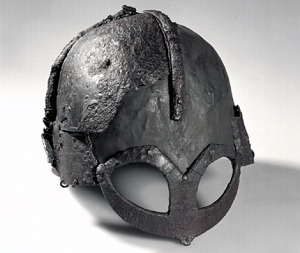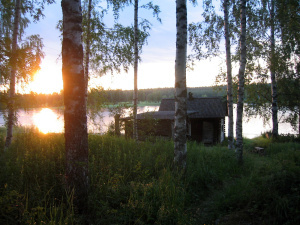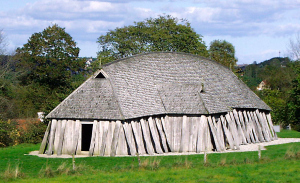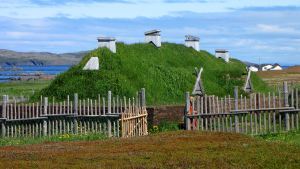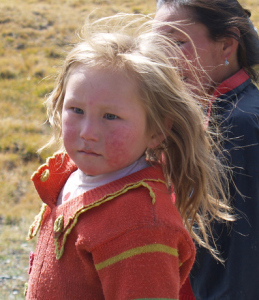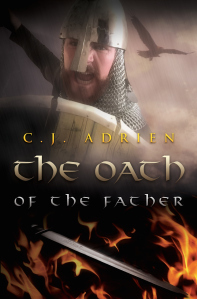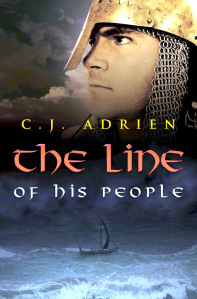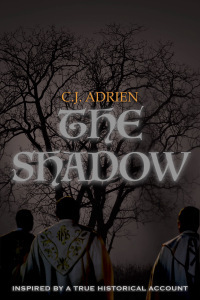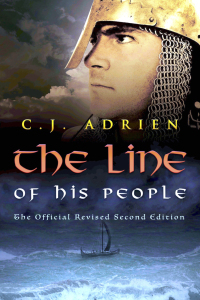C.J. Adrien's Blog, page 17
December 29, 2015
7 Wonders of the Viking World
The Vikings didn’t leave much behind in the way of brick and mortar buildings, but what we do have from them is all tremendously awe-inspiring. They are not the hanging gardens of Babylon, but the following are seven of the most wondrous finds dating back to Viking Age Scandinavia.
1. Gokstad Ship
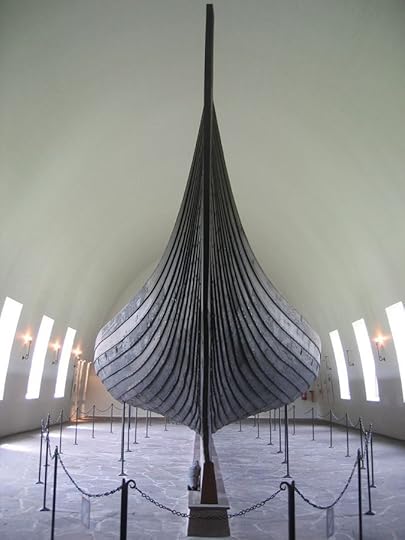
It seems appropriate to begin with the ship that began our modern fascination with the Vikings. Prior to the discovery of the Gokstad ship, no one in the 19th century had ever seen a Viking ship up close. The only evidence for the style and build of Viking ships came from the Gotland Stones which depicted Drakkars sailing. Beginning with the Gokstad ship, a new kind of inquiry into the Viking Age began, leading historians to formulate new conclusions about a previously misunderstood people. Within the ship itself were a wealth of artifacts that are studied to this day. Currently preserved and on display at the Viking Ship Museum of Oslo, Norway, this beautiful specimen of Viking Age craftsmanship is well worth a visit.
2. Oseberg ship
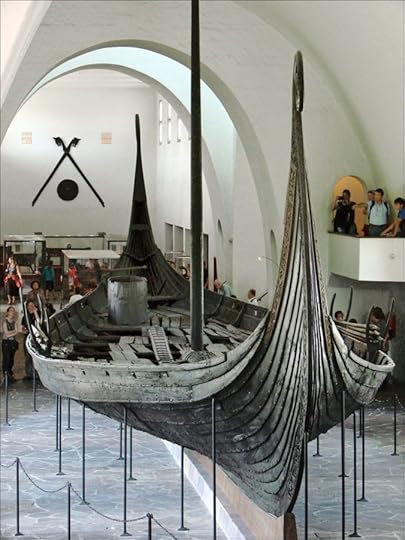
The Oseberg ship is a tremendously important discovery that has helped to illuminate many aspects of the Viking Age that were previously completely unknown. Unlike the Gokstad ship, the Oseberg ship possesses more decorations and carvings, including a prow in the shape of a serpent. Buried with the ship were two women with a large amount of grave goods made up of everyday items. These items have helped to reconstruct a few aspects of daily life in the Viking Age. One woman is thought to have been a slave and the other a ruler or possibly a mystic, although these suppositions are unclear.
3. Temple at Upsalla

Olaus Magnus Historia om de nordiska folken. Bok 3 – Kapitel 6 – Om ett härligt tempel helgadt åt de nordiska gudarna. – Utgivningsår 1555.
All that remain of the temple at Upsalla are pole holes in the ground that once held the pillars which formed the outer wall. Luckily, there remains evidence of its construction, including drawings by Adam of Bremen which depict the temple at its peak. According to several sources, the temple was an important religious center that attracted visitors from all over the Viking world and conducted human sacrifices. It is a shame the structure has not survived until today.
4. Groix Ship Burial

The island of Groix off the coast of Brittany in modern day France is an unassuming vacation spot for locals looking for a getaway at the beach. In the early 20th century it was the site of something more. A ship burial was uncovered along with several artifacts that have left archeologists and historians puzzled. The ship itself was badly damaged and not well preserved and the grave goods in it were also damaged. Nevertheless, what makes this find unique is the large number of shield bosses that were found. Most were made in the Norse style, but several among them were made differently. It appears they were constructed using local metals, and their design may have been purposeful to adapt to the weaponry of the Bretons.
5. Stora Hammars Stones

Part of a larger collection of Gotland Stones, the Stora Hammer Stones paint a picture of the Viking Age from the perspective of the Vikings themselves. The stones once served as the only reference to the style of ships the Vikings sailed, and were the only corroborating evidence for what European writers had chronicled durning the Viking Age. From a historian’s perspective, these stones have been and continue to be one of the most important remnants of the time.
6. L’Anse aux Meadows
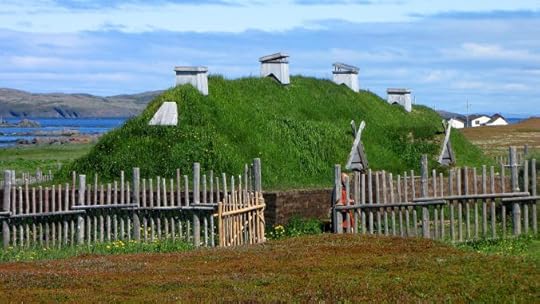
Very little has survived from the first Norse colony in the Americas, but enough has been found over the years to know that a settlement did indeed exist. The true wonder at L’Anse aux Meadows is the modern recreation of the settlement stylized in the Greenland and Icelandic traditions based on the evidence found in the ground. It is a sight worthy of the seven wonders.
7. Vale of York Hoard
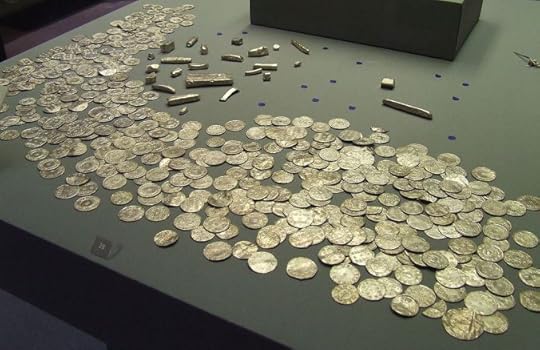
When speaking of “wonders of the world” it is difficult to imagine including a treasure trove. Yet for the Vikings, who were in the most basic sense pirates, a hoard of buried treasure seems quite appropriate. The Vale of York Hoard is a recent find dating to 2007 and one of the largest ever found. What makes it truly special is the quality of preservation of the pieces and the sheer number of them. Mostly made up of coins, the hoard is valued at over £1 million and is thought to have originally belonged to a church. The treasure was either stolen in a raid or given as tribute and its owner was killed without passing on its whereabouts.


December 9, 2015
Normandy’s Other Founder Who History Forgot
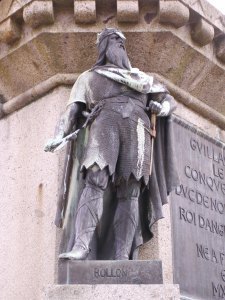
A statue of Rollo in the town of Falaise
The first ruler of Normandy, the mighty Viking Rollo, did not accomplish all that he did alone. Described as a tall, powerful man, he made a most surprising transition from sea rover to monarch, and in so doing transformed himself from a pagan marauder into a legitimate Christian ruler. Normandy is an interesting case because the Vikings who settled there as rulers recognized the need to adapt to their new home to maintain legitimacy. Rollo, by example, married into French royalty and played the game of politics well. Norman rule over the region would eventually become the guiding hand of Europe’s future.
The story of the Normans and their first ruler is undoubtedly one of the most incredible success stories in history, but there is one man who was present and heavily involved who everyone seems to have forgotten. Rollo had a relative, and to illustrate how little we know of him, we are unsure if he was Rollo’s brother or uncle. All we have is a name.
His name was Malahulc.
In 1158, Fulk Paynel, a herald and a historian, put together a family tree of the Norman line from alms housed at Servon-sur-Vilaine Abbey, as well as from records of Tithes paid to the church. His aim was to trace back the family of Robert D’Avranches (the knight who was paying him) to find a connection between both William the Conqueror and Rollo of Normandy. He successfully found a connection to both, but he also found a direct line to Malahulc, a man who history appeared to have forgotten already. Yet from his research it appeared that a major portion of the nobility in Normandy (up to half) could trace back to this man. From the genealogical record we know nearly nothing, and the only other attestation to Malahulc is from William of Jumièges who described him simply as a relative of Rollo.
Why did this man disappear from the historical record? He was evidently present and involved in the early Norman kingdom as well as a relative of the new ruler, so how can it be that he is not more widely known or attested to? We will likely never know, but the fact remains: by virtue of his relation to Rollo, he must have played a major role in the early Norman kingdom. As a matter of conjecture, it is possible that he and Rollo had a falling out at some point, perhaps over religion (Rollo converted to Christianity via baptism, but perhaps not Malahulc). This may explain his rather suspicious absence from history—he may have been the victim of political sabotage, purposefully omitted by chroniclers of the time for his refusal to be Christian. The reality here is that we simply cannot know, but it’s always fun to speculate.


December 4, 2015
Santa Claus: Odin in Disguise?

Sinterklaas
’Tis the season to be jolly, but is the mythical figure of Santa more than meets the eye? The Santa Claus of today is a rosy-cheeked, portly, elderly man donning a red onesie with white trim and a delightful red winter cap–a stark contrast to his alleged inspiration Saint Nicholas. So who is Santa, really? Where did he come from, and why has he prevailed in the public consciousness as successfully as he has?
Saint Nick
The historical origins of Santa Claus reside with a figure known as Saint Nicholas. Saint Nicholas was a Greek bishop in the early 4th Century whose many accomplishments, including protecting children, led to his canonization. A great deal of folklore and legend emerged from his numerous deeds, many of which offer tales of his verdant efforts to protect children from harm. He quickly became known as the protector of children and sailors, the former being the main source of inspiration for the modern Saint Nick. All across Christendom, Saint Nicholas’ reputation spread and his birthday, December 9, became a day of good luck. His association with Christmas has remained fairly consistent through the centuries, but his name has changed over time. Santa Claus is a North American corruption of the Dutch name SinterKlaas which was imported to the Americas in the mid 18th Century when New York was still New Amsterdam. Ever since, the holiday season has prominently featured the saint in his Dutch incarnation.
From Tan Mediterranean Man to Pale, White-Haired Pole-Dweller
One of the great mysteries of the holiday season is how Saint Nick transformed from a skinny, dark-skinned mediterranean man to a fat, elderly white man. The traditions surrounding Saint Nick were likely well established by the time Christendom began its great expansion into Northern Europe, led substantially by the 8th Century ruler Charlemagne. Over the course of the 9th, 10th, and 11th Centuries, Christianity spread across all the Scandinavian countries and even further East up to the borders of modern day Russia. This expansion was not universally well received, and pagan rituals continued well into the medieval period in isolated areas. It is theorized that the pagan tradition of Yule, which coincided with the celebration of Saint Nick, may have led to an assimilation of sorts of both traditions into one.
Odin, Yule, and the Last Breath of Germanic Paganism
Prior to their Christianization, Northern Europeans celebrated a holiday around the same time the Christians celebrated Saint Nick. Yule was a midwinter festival theorized to have had an association with a variety of other pagan traditions, including heightened paranormal activity and an increase of Draugrs (the walking dead). To decorate for this three-day occasion, they brought in evergreens which symbolized the continuity of life through winter. Odin figured prominently in the Yule tradition. It was said that he wore a blue-hooded cloak and rode his eight-legged horse Sleipnir through the sky at night and stopped place to place to deliver gifts. The exact significance of Yule in Germanic paganism, as well as the exact rituals practiced during the celebration, remain relatively ambiguous in the historical record. Despite this, historians and enthusiasts alike have postulated a strong connection between Odin’s role in Yule and the role Santa would come to play in Western culture later on.
An Opportunistic Odin?
It is possible, but of course not certain, that Pagans may have seen similarities between Saint Nick and their own Odin (or Woden, or ), and may have transposed many of Odin’s characteristics onto the saint. After all, both were associated with a specific time of year, a specific holy day, and both were associated with some form of giving gifts. This could explain why the variations of Santa across Europe depict him as a magical, wandering, white-bearded man of varying powers. In a way, as Norse and Germanic Paganism saw its twilight, the god Odin found an opportunity to live on in some form through the figure of Saint Nicholas. His metamorphosis may not have been discouraged either: the Christian church was keenly aware of the advantages of molding their faith to their audience to encourage conversions.
So, is Santa Odin?
Ultimately, there is no solid evidence to definitively link the two, we only have lofty inferences based on scattered bits of information. It is up to each person to believe what they want to believe about Santa. More importantly, it is up to each person to decide on what Santa means to them during the holiday season. Personally, I like to think that today’s Santa is the latest incarnation of Odin who, over the course of many sagas, metamorphosed numerous times. It would not be a stretch of the imagination for a Viking to believe that Santa is merely his latest disguise.
Happy Holidays!


November 12, 2015
Odin? You Mean [insert one of hundreds of name variations]!
You know him as Odin. The marvel universe knows him as Odin, and by extension every 8-18 year old boy in the world knows him as Odin. While today we give him a single name by which to identify him, the deity himself has over the millennia had a tremendous variety of names, most of which you probably have never heard. To historians, part of what makes Odin such a fascinating character is his tremendous laundry list of names by which various Germanic tribes identified him. Some of them have survived to today in our culture, such as the naming of the day Wednesday, or originally Woden’s Day, Woden being another name for Odin. The following list is but a sample of the names given to this incredibly versatile deity, and is only representative of a number of names historians have encountered. How many others have been lost to history is a mystery, but there certainly must have been many, many others.
The first mention of the pan-Germanic deity known as Odin comes to us by way of the Romans. The historian Tacitus wrote in his early 1st Century book Germania about a deity he equates to the Roman god Mercury. He further describes the rituals used to worship him, such as a mixture of human and other sacrifices, as well as offerings of food and trinkets.
From his beginnings as a Germanic deity, the root of his many German names is thought to be Wōđanaz. This name morphed over the centuries into divergent forms such as Woden, Wođen, Wotan, and Wuotan.
By the Viking Age, Scandinavians had adopted a variation of the name as Ođinn, or Odin, the form most familiar to us today. Yet this variation of the name was not universal across Scandinavia. His name likely took on many other variations, many of which are lost to us today.
Aside from his name variations, the deity most widely know as Odin was, as previously discussed, a versatile god. In fact, one of his traits was that he was able to fulfill many roles and wear many hats, and for each one of these incarnations he was given a name. In the Poetic Eddas, he is given a tremendous variety of names depending on the role he was playing in each myth or story. It must be noted that in the old Norse language, names and nicknames were composites created to describe a person within the name. These additional names are thought to have been assigned as nicknames in response to specific deeds or actions, used by Skalds (the people who recited the myths in poetic form) to help them remember a particular story. If someone asked for a story about Odin by a particular name, that name would contain the information the Skald needed to know which story to recite. Thus, this long list of names was created:
Aldaföðr: Father of Men
Aldagautr: God of Men
Aldingautr:the Ancient God
Alfaðir, Alföðr: All-Father
Angan Friggjar: Delight of Frigg
Arnhöfði: Eagle-headed One
Asagrim: Grim Lord
Ascaric: Spear-King (Frankish)
Atriði, Atriðr: Attacking Rider
Auðun: Wealth Friend
Bági gulfs: Enemy of the Wolf
Baldrsfaðir: Father of Balder
Báleygr: Blazing Eye
Biflindi: Shield Shaker
Bileygr: Feeble Eye (possibly One Eye)
Björn: Bear
Blindi, Blindr: Blind One
Bölverkr: Bale-worker
Böðgæðir: Battle Enhancer
Bragi: Chieftain
Bruni, Brunn: Brown One
Burr Bors: Son of Bor
Darraðr, Dorruðr: Spearman
Draugadróttin: Lord of the dead
Ein sköpuðr galdra: Sole Creator of Magical Songs
Ennibrattr: One with a Straight Forehead
Eyluðr: Ever-Booming
Faðmbyggvir Friggjar: Dweller in Frigga’s Embrace
Frumverr Friggjar.: First Husband of Frigga
Faðir glades:Father of Magical Songs
Farmaguð, Farmatýr: Cargo God
Farmoguðr: Journey-Empowerer
Farmr arma Gunnlaðar: Burden of Gunnlöð’s Arms
Farmr galga: Gallows’ Burden
Fengr: Snatcher
Fimbultýr: Mighty God
Fimbulþulr: Mighty Poet
Fjölnir: Very-Wise or One Who Conceals
Fjölsviðr, Fjölsvinnr.: Much Wise
Foldardróttinn: Lord of the Earth
Forni: Ancient One
Fornölvir: Ancient Oelvir
Frariðr: One Who Fares Forth
Fundinn: The Found
Furor: Fury
Gagnráðr: God of Gainful Counsel
Galdraföðr: Father of Galdr
Gallow’s Lord
Gangleri: Wanderer
Gangráðr: Journey Advisor
Gapthrosnir: One in a Gaping Frenzy
Gauti, Gautr: God
Gausus: God (Langobardic)
Geiguðr: Dangler
Geirloðnir: Spear Inviter
Geirtýr: Spear God
Geirvaldr: Spear Master
Geirölnir: Spear Charger
Gestr: Guest
Gestumblindi: The Blind Guest
Ginnarr: Deceiver
Gizurr: Riddler
Glapsviðr: Seducer
Goði hrafnblóts: Goði (priest) of the Raven-offering
Godjaðarr: God- Protector
Göllnir, Gollor, Gollungr: Yeller
Göndlir: Wand Bearer
Gramr Hliðskjalfar: King of Hliðskjalf
Grímnir, Grímr: The Masked One or The Hooded One
Grímr: Masked or Grim
Gunnar: Warrior
Gunnblindi: Battle Blinder
Guodan: Master of Fury (Langobardic)
Guodan, Gudan: Master of Fury (Westphalian)
Hagvirkr: Skillful Worker
Hangaguð: Hanged God
Hangi: Hanged One
Haptabeiðir: Ruler of Gods
Haptaguð: Fetter God
Haptasnytrir: Teacher of Gods
Haptsönir: Fetter Loosener
Hár: High One
Hárbarðr: Grey Beard
Hárr.: One Eyed
Hávi: High One
Helblindi: Host Blinder
Helmet-capped Educator
Hengikeptr: Hang Jaw
Herföðr, Herjaföðr: Host Father
Hergautr: Host Gautr
Herjan, Herran: Lord
Herteitr: Glad in Battle, possibly also Gladness of soldiers
Hertyr: Host God
Hildolfr: Battle Wolf
Hjaldrgoð: God of battle
Hjaldrgegnir: Engager of Battle
Hjálmberi: Helm Bearer
Hjarrandi: Screamer
Hlefreyr: Famous Lord or Mound Lord
Hild’s Noise Maker (hild = battle)
Hnikarr, Hnikuð: Thruster
Hoarr: One Eyed
Honger – Hunger
Hotter: Hatter
Hovi: High One
Hrafnfreistuðr: Raven-tester
Hrafnáss: Raven God
Hrammi: Fetterer or Ripper
Hrani: Blusterer
Hrjotr: Roarer
Hroptatýr: Lord of Gods, God of Gods, or Tumult God
Hroptr: The Maligned One or The Hidden One, or Tumult
Hrossharsgrani: Horse-hair Mustache
Hvatmoðr: Whet Courage
Hveðrungr: Roarer
Itreker: Splendid Ruler
Jafnhár: Just As High
Jalfaðr: Yellow-brown Back
Jálg, Jálkr: Gelding
Jarngrimr: Iron Grim
Jolfr: Horse-wolf or Bear
Jölföðr: Yule-father
Jölnir: Yule Father
Jormundr: Mighty One
Karl: Old Man
Kjalarr: Nourisher
Langbarðr: Long Beard
Loðungr: Shaggy Cloak Wearer
Lord of the Wild Hunt , Wilde Jaeger
Niðr Bors: Son of Borr
Njotr: User or Enjoyer
Óðinn: Frenzied One
Óðr: Frenzy, Inspiration, Breath
Ofnir: Inciter
Olgir: Protector or Hawk
Ómi: One Whose Voice Resounds
Óski: Wish Bringer or Fulfiller of Desire
Ouvin: Master of Fury (Faroese)
Rauðgrani: Red Moustache
Reiðartyr: Wagon God
Rognir: Chief
Runatyr: God of Runes
Runni vagina: Mover of Constellations
Sanngetall: Truth Getter or He Who Guesses Right
Sannr, Saðr, Sath: Truth or The Truthful
Siðgrani: drooping mustache
Siðhottr: Broad Brim, Deep Hood, or Slouch Hat
Siðskeggr: Long Beard or Broad Beard
Sigðir: Victory Bringer
Sigföðr: Father of Victory
Siggautr: Victory God
Sigmundr: Victory Protection
Sigrhofundr: Victory Author
Sigrúnnr: Victory Tree
Sigthror: Victory Successful
Sigtryggr: Victory Sure
Sigtýr: Victory God
Skilving, Skilfing: Trembler (a reference to seidhr or to battle fury?)
Skollvaldr: Treachery Ruler
Sonr Bestlu: Son of Bestla
Spjalli Gauta: Friend of the Goths
Sváfnir: Luller to Sleep (or Dreams), or Closer
Sveigðir: Reed Bringer
Svipall: Fleeting or Changeable
Sviðrir: Wise One
Sviðurr: Wise One
Svolnir: Sweller
Thekkr: Welcome One
Thrasarr: Quarreler or Raging, Furious
Thriði: Third
Thriggi.: Triple
Thrór: Burgeoning or Inciter to Strife
Throttr: Strength
Thrundr, Þund : Sweller
Thunnr, Þuðr: Lean or Pale
Tveggi: Double
Tviblindi: Twice Blind
Unnr, Uðr: Beloved, Lover
Váði vitnis: Foe of the Wolf
Váfoðr, Vafuðr: Dangler
Váfuðr: Wayfarer
Váfuðr Gungnis: Swinger of Gungnir
Vakr: Vigilant
Valdr gala: Ruler of Gallows
Valdr vagnbrautar: Ruler of Heaven (I’m not 100% convinced of this translation)
Valföðr: Father of the Slain
Valgautr: God of the Slain”
Valkjosandi: Chooser of the Slain
Valtamr, Valtam: Slain Tamer or Warrior
Valtýr: Slain God
Valthognir: Slain Receiver
Vegtamr: Waytamer
Veratýr: God of Being
Viðrir: Stormer
Viðfraegr: Wide-famed
Viðrimnir: Contrary Screamer
Viðurr: Killer
Vingnir: Swinger
Vinr Lopts: Friend of Loptr
Vinr Lóðurs: Friend of Lóðurr
Vinr Míms: Friend of Mímir
Vinr stalla: Friend of Altars
Vodans: Master of Fury (Gothic)
Voefuðr: Dangler
Völsi: Ever Ready Phallus
Völundr rómu: Smith of Battle
Vut: Master of Fury (Allemanic, Burgundian)
Weda: Master of Fury (Frisian)
Wild Huntsman, Wilde Jaeger (German)
Wôdan: Master of Fury (Old High German)
Woden: Master of Fury (Anglo-Saxon)
*Wôðanaz: Master of Fury (proto-Germanic)
Wolf: Wolf (German)
Wuotan/Wuodan: Master of Fury (Langobardic, Old High German)
Wunsch: Wish (German)
Yggr: Terrible One
Yrungr: Stormy
LIST SOURCE 1
Odin’s latest incarnation of course is Santa Claus, meaning Giver of Gifts in the language of children. (I’m joking…or am I?)
I am currently hosting a giveaway for a paperback copy of my second novel, the oath of the father. CLICK HERE to enter for a chance to win!


November 11, 2015
3 Often-Ignored Truths About the Study of the Vikings
When reading online articles about the Vikings, it’s easy to get suspicious about the veracity of an author’s sources. The pressure to publish–and publish frequently–means taking a quantity over quality approach to writing about history. Although not immune to errors, I have personally begun to see a great many articles circulating in social media circles that are highly suspect. Most notable among these was the claim by one author that half of all Viking warriors were female. While a romantic thought, it is not accurate. The study sited by the article was grossly misinterpreted to fit into a carefully molded and wishful idealism of who the Vikings really were. In truth, Viking Age Scandinavians travelled and settled far away lands, but like the settlers of the New England colony, for example, the presence of women did not mean that half of New England’s militia were female. That is why I feel it is important to communicate to my readership the reality that is the study of Vikings in academia. There is no clear-cut narrative, and everything from how they built their ships to how they prayed to their gods is a big maybe.
Nearly every “fact” about the Vikings is debatable.
1,000 years separate us from the last of the Vikings, and that distance means we have completely lost touch with who they were. Despite efforts to reconstruct their culture and belief systems, academics are mostly in the dark about the bigger picture of Viking Age Scandinavian paganism and society. As with everything else, there are those out there in the webisphere who will claim to know otherwise, but the reality is that the Vikings’ culture was obliterated and assimilated by Christianity long ago. They left no written record, and the documents we do have are post-Viking age writings by Christian clerics whose veracity in their assertions is certainly worth suspicion. The last 20 years of study on the Viking Age have produced a wealth of new finds whose discoveries have shattered old paradigms and rewritten history, but have at the same time complicated the field. Therein lies the caveat to the study of Vikings: we have lofty clues about who they were with no definitive answers.
Archeological finds have complicated the field.
One might think digging up clues in an investigation might help to piece together a more accurate picture of the Vikings, but this is certainly not the case. As an example, we have the Osberg ship whose burial artifacts raise more questions than they answer. The woman buried with the ship, and her companion who is assumed to have been her slave (but not for certain), also raise questions. Some theorize she was buried because she was a person associated with magic, while others think she may have been royalty. Her post-mortem condition further complicates things as she suffered from physical deformities and, according to a recent genetic study, had a propensity to grow hair where women typically do not. Were the physical deformities valued? Did they hold significance in the community? (for a full synopsis on the Osberg burial and the questions it raises, read Robert Ferguson’s Vikings) All of these finds have done little to help us accurately reconstruct Viking Age society in Norway. Although this may seem frustrating to the average history buff, the fact that the field is further complicated by these mysteries is an exciting prospect for an archeologist or historian. It is an exciting time to be an academic in the field of Viking history!
Ultimately, we know very little for sure.
To illustrate how little we know about the Vikings, historians prior to the year 1900 didn’t even know for sure if the infamous dragon-headed prows of legend had ever actually existed. In fact, until the discoveries of the Gokstad and Osberg ships in the early 1900’s, historians were not even certain of the shape of the ships. Other than the Gotland Picture Stones, historians had very little to go on. Certainly we now know more than we did 100 years ago, but what we knew back then set an incredibly low bar. Thus, one of the most important things to remember about the study of the Vikings is that we know very little, and everything we see published either in books or on the internet is but one interpretation of the clues, subject to debate and re-evaluation and to be labeled a big, fat MAYBE.
On a final note, I am hosting a giveaway for my second book in paperback form. There will be three winners, ENTER NOW to see you will be one of them!


November 1, 2015
3 Facts About Viking Saunas to Use at Dinner Parties
If you enjoy having interesting pieces of trivia to share at family gatherings during the holidays, or just to have on hand at dinner parties with friends or colleagues, you will want to hold on to these three facts about the use of saunas during the Viking Age.
Sauna Fact #1: Saunas were also dwellings (at first).
Among their many other claims to fame, the Finns are probably most proud of having invented the sauna. The first saunas are thought to have doubled up as the primary dwellings of early Finns, and they began turning their houses into saunas by heating stones in the fireplace for extended periods of time and pouring water over these stones to create steam. The temperature in the room is thought to have risen enough for the Finns to take off their clothes. What happens after that is well known history.
Sauna Fact #2: Saunas were a common feature on Viking Age Scandinavian Farms.
The Vikings are known for many things, but cleanliness does not usually top the list. Interestingly, the people we refer to today as the Vikings were in fact extremely personal hygiene oriented. Recent revisions to history have demonstrated that cleanliness was a cultural must among the pre-Christian Scandinavians. Saunas were readily adopted from Finland and became a common feature of the farmstead. Like their Finnish neighbors, they used heated rocks to create steam in small washrooms and bathe at least once per week if not more. The Vikings also made use of hot springs to bathe in winter where available.
Sauna Fact #3: Vikings loved their saunas so much, they built them where they went.
It seems obvious that Scandinavians who left home would take with them a desire to remain clean in their new colonies, but until recently building saunas abroad was not a verifiable practice. Evidence of Viking saunas abroad have turned up in archeological digs in several countries in recent times, supporting the idea that saunas were a cherished cultural phenom. Most impressive among the finds is evidence that colonists in Greenland and Newfoundland built saunas, leaving behind traditional bathing platforms and an array of scorched stones.
Further reading:
Dubois, Thomas. Nordic Religions in the Viking Age. University of Pennsylvania Press, 1999
Nordskog, Hautala. The Opposite of Cold-The Northwoods Finnish Sauna Tradition. University of Minnesota Press, 2010.
October 27, 2015
Do You Have Viking Blood?
It’s no secret that the Vikings were prolific (and terrific) progenitors. They travelled far in search of riches, and often those they encountered were of interest to them in more ways than one. A recent study in the Orkneys found that the local population’s belief that their ancestry stemmed back to Ireland was in fact wrong. Instead, most of the island’s population are of Norse heritage genetically. Surprises such as these are actually common. Communities often build elaborate stories about their ancestry, but recent advances in genetic testing have allowed researchers to paint a very different picture of who is made of what. When it comes to the Vikings, for example, it turns out they did not simply show up, pillage, rape, and leave, but instead colonized favorable areas, leaving behind a highly pronounced genetic lineage. Thus begs the question: do you have Viking blood?
If you don’t think you have Viking blood in you, think again. The Scandinavians of the Viking Age spread their seed and their people across the known world. Below is a list of modern countries and how likely you are to be a Viking descendant if you are from one of them.
U.K. — the city of York was once the Norse city of Jorvik, and the Vikings at one time had carved out half of Britain for themselves in a territory called Danelaw. In 1066, England was invaded by William the Conquerer and his army of francophone Vikings, the Normans (French for ‘north men’). If your are British or Scottish, it is VERY likely you have Viking blood in you. In fact, recent studies have shown that nearly one quarter of all Britts are directly descended from the Vikings. In Scotland, it’s a slightly different story. Although not as widespread, Norse heritage is still a prominent piece of the genetic pie.
Ireland — the cities of Dublin, Wexford, Cork, Limerick, among others were founded by the Vikings. If you are Irish, it is VERY likely you have Viking in you. Interestingly, there are some who theorize that the iconic Irish red hair was a Norse import rather than a Celtic one, although without proper genetic testing it is just an unproven theory. Ireland struggled for many years to rid themselves of the Vikings. Particularly, the great kings of Leinster such as Muiredach Mac Ruadrach swore specific oaths to the church to help push back against the pagan invasion. In 847, the Irish scored several key victories across the island which effectively expelled most of the Norse settlers from their lands, but fewer than two decades later they returned. Viking settlements in Ireland played the game of politics well and over the course of the next century and a half established themselves firmly in Irish lands and the Irish genetic pool.
France — Normandy is the obvious region of France one thinks of when thinking of the Vikings. But Brittany (Bretagne) and the Vendée regions of France were also heavily settled by displaced Scandinavians in search of a new home. If you are from Western France, it is VERY likely you have Viking in you. If you are from Central or Eastern France, it is not likely—those regions are genetically German. Along the coast, the Vikings built more lofty settlements than they had in Ireland, most likely due to the fact that the Carolingian empire was a much more difficult foe to face than the kings of Leinster. According to sources, the Norsemen who pushed into Brittany were from Norway, having sailed around the U.K. and down through the Irish Sea to reach it. As they carved out swathes of land for themselves in the late 9th and early 10th centuries, the Norwegians came into conflict with the Danes in Normandy. It was by exploiting this conflict that the Bretons were able to push back their invaders and eventually expel them from the region. Still, their century-long presence left an indelible mark on the local genetic pool.
The Netherlands — The Netherlands were heavily raided for centuries and colonized on multiple occasions by the Danes. In the long run, however, the Franks maintained too strong a dominion over the region, causing the Northmen to flee. If you are dutch, it is SOMEWHAT likely that you have Viking in you.
Spain — The coast of Asturias was attacked several times by the Vikings. What’s more, they successfully sacked Lisbon and captured Seville and inflicted great fear in the Moors. However, they did not colonize Spain heavily, therefore if you are from Spain or Portugal, you only have a SLIM chance of having Viking blood, but a chance nonetheless. Following the humiliating defeats at the hands of the Norsemen, the Moors quickly built up their navy which successfully repelled Viking attacks in the second half of the 9th century. Hastein, a supposed son of Ragnar Lothbrok, partook in an infamous excursion into the Mediterranean which ended mostly in disaster due to the strength of the Moorish fleet guarding the straight of Gibraltar.
Italy — If you are from an area in Italy that was once part of the Norman kingdom of Italy, you are VERY likely to have Viking blood in you.
Russia, Ukraine, Poland, Estonia, Latvia, Lithuania, Belarus — Russia was named after the Swedish Vikings known as the Rus. The Rus helped to found the city states of Kiev and Novgorod, as well as Moscow. The Tsars considered themselves direct and proud descendants of the Rus. If you are from these regions, you are EXTREMELY likely to have Viking blood in you, especially if you are light skinned. Over several centuries, the Rus exerted their power over the slavic states and added a great deal of their genetic material to the mix. They travelled as far as Constantinople and even served as the Emperor’s personal body guards, today referred to as the Varangian Guard.
The Balkans — The Rus travelled as far as Constantinople, and many stayed there to father children…lots and lots of children. There is a very slight genetic pool from Scandianvia in the Balkans today, but it is fairly limited.
Mongolia — Although the Vikings never travelled as far as Mongolia, the Mongolian Golden Horde did invade and occupy Eastern Europe and brought back to Mongolia their favorite new pets — blue-eyed blonds. Today there is a recessive gene in Mongolia by which children are born with light hair and blue eyes. Since we know about the Vikings in Russia, specifically their blue-eyed blond-haired descendants, we know that Norse genes were present in the areas conquered by the Mongols. Those with Norse traits were the more likely choices for slaves for the Mongols to take home and show off (and rape and make children and so on). It may be inferred that the recessive blue-eyed blond hair genome in Mongolia today is from the Vikings. For that, of course, we have Genghis Kahn to thank. See the picture below of the genetic trait in question:
Don’t forget that I wrote a couple of fun action/adventure books about the Vikings in France. They are:


October 13, 2015
The Shadow – A Historical Short
THE SHADOW
a historical short story
The following is a work of fiction. Names, characters, businesses, places, events and incidents are either the products of the author’s imagination or used in a fictitious manner. Any resemblance to actual persons, living or dead, or actual events is purely coincidental.
Preface
The following short story was inspired by an actual account as it is found in the Annals of Fulda. The original account describes strange events perpetrated by a maleficent entity who allegedly tormented the village of Bingen (modern day Germany) for three years in the latter portion of the 9th Century. The authors of the annals present the story not only as a mere side note of the greater history of the Carolingian Empire, but also as a stark reminder of the dangers presented by the spiritual world.
It must be noted that the medieval period as a whole was an age of belief, meaning nearly everyone would have accepted that there is a God unquestioningly. Therefore this story at the time would have been easily accepted as true and would have disturbed those who heard it. This story also happens to be one of the earliest accounts of a Christian exorcism, although the methods described are hardly reminiscent of what that practice has become today.
Was there a maleficent being causing trouble in a remote German village in the late 9th century? The answer is for the reader to decide.
The Shadow
I was eleven when He arrived in our village. No one knows where He came from nor why He came. There had been three generations of men since the great Charlemagne had brought Christ to our people. The priests told us the light of Christ would protect us from pagan evils, that we would be cleansed of pagan sin. But Christ was not there when He arrived. Christ did not protect us when He burned our houses and our fields.
My father was a farmer. His field was plotted between the edge of the village and the dark Bingen forest. Most houses were made of wood and straw, except for that of the priest who had begun to construct a stone church with money sent to him by the church in Ingleheim. Our town sat on the border with Lotharingie, a land that had changed hands so many times between bickering lords that there existed an anarchy. Bands of marauders often emerged from the forests to attack the rich villages along the Rhine, including Ingelheim. We were fortunate. As a poor farming village, the bands often passed through without stirring up trouble. We did, however, live under constant threat, for we did not know if one of these groups of bandits might someday attack our village. Fortunately the local lord pushed back against the raids and built a wooden watch tower on the edge of the Rhine and the forest. For a time at least, the raids subsided.
Within the community, my father held a prominent position on the village council which oversaw the laws governing farming. He was respected by his peers and our family was prosperous as far as poor farmers were concerned. We did not go hungry often. I brought pride to my family too at the age of ten by enrolling in the local priest’s school to learn how to read and write. All children did not earn such a privilege, as pupils were hand picked based on a brief aptitude test. This was good for my father because if I joined the church, I would not become a farmer, leaving my older brother Adalbert as the sole inheritor of our lands. Not until He arrived did our lives take a dark turn, when we were dragged unwillingly into the meddling of the next world.
Strange things began to happen on the eve of our first harvest of that year. Father remained awake much later in the night than usual to sharpen his tools by the central fire in our one-room house. I remember feeling safe and snug in my straw bed beside my brother along the far wall while the fire dwindled. As my eyes closed and my mind wandered into the realm of sleep, we heard a loud knock at the door. It awoke everyone. Father stood with a scythe in his hand, concerned who might have arrived at our door. Villagers seldom ventured outdoors at night. There were too many dangers, such as bandits and wolves. Living so close to the forest meant any number of things roamed our fields at night. Our minds wandered; our hearts raced.
“Who goes there?” father said.
He was answered by silence. Carefully, he pulled the latch that kept the door locked and pulled open a narrow gap, keeping his foot wedged against the bottom in case of trouble. In the darkness, he saw nothing. He closed the door and latched it. Relieved, he sat by the fire to continue sharpening his tools. He looked at me in the corner and saw the flames of the fire reflect off of my eyes.
“It was nothing. A bird must have struck the wall. Go to sleep,” he said.
I tried. I closed my eyes and prayed for my mind to wander into the world of sleep again, but the fear from the sound had invigorated me. My heart raced still. Beside me, my brother began to snore. I hated him for how easily he fell asleep. His snoring had kept me awake many a night. The fire continued to dwindle as my father remained awake at its side. Suddenly, we heard another knock. Across the room against the opposite wall, my mother sat up in her bed, struggling to raise herself with her hands to prop up her swollen belly. She was with child and ready to give birth at any moment.
“What is it?” she asked my father.
He said nothing as he approached the door, unlatched it, and looked outside. There was no moon that night, so he peered into utter darkness. I saw him kneel to the ground and reach his hand outside. As he pulled in his hand, he examined a smooth river rock, which was out of place in our village. The Rhine River was an hour’s walk away along the main road, and the rock could not have landed at our door on its own. Terrified, my father slammed the door shut and latched it. He sat beside the fire, gripped his scythe and knife, and stared at the door. An eerie silence enveloped us. Even the crickets had ceased their chirping.
Another knock rang out, and we all jumped. Father stood to his feet, visibly stressed and anticipating the worst. I sat in my bed along with my brother, and we held each other in fear. Mother waddled her way to the fire and pulled from it a hot iron. Both my parents stood before the door, ready to confront whoever it was who was throwing rocks at our house. Finally my father’s patience waned. He dashed to a corner of the house to dig through a pile of items from which he drew a long wooden shaft with a tightly wrapped cloth on the end. It was the torch he had bought from the priest a few weeks past, which he was saving for exactly this kind of situation.
“All of you stay here,” he said.
He lit his torch and ventured into the village. We listened. At first there was nothing, but then we heard shouting. I recognized the voice. Our neighbor Gunther had also left his house. A third voice echoed out. Another neighbor came out from his house and then another. After a brief time it seemed the whole village had left their houses in the middle of the night.
“Which one of you is throwing rocks at my house?” yelled one man.
“My house too,” said Father.
“And mine!” another said angrily.
They bickered, blaming one villager or another for this outrageous disturbance on the eve of harvest. Some shouted far fetched conspiracies about others trying to steal their harvest, while others blamed someone’s unruly children for tormenting upstanding villagers. Even the priest joined in the fray. He had only joined the shouting match to broker peace, not yell about a disturbance.
“I found these river rocks at my door!” Father shouted.
“So did I!” another man said.
I looked out the door myself to see the commotion. My father stood at the center of a crowd, the only man with a torch. He would be angry in the morning for allowing such an expensive commodity to burn down for what increasingly seemed to be a false alarm, but his torch allowed the villagers to at least meet and discuss what had happened. They continued to blame one another for the disturbance, emotions running high and fear running rampant.
“It was your children, Theudman,” Gunther said, accusing my father. “A thirteen and a ten year old—they are the only boys in the village capable of this kind of mischief!”
“My children were at home with me,” Father said. “They are not to blame.”
“Then who?” asked another man.
“There is nothing to fear,” said the priest. “These disturbances must be related. Perhaps it was a flock of birds carrying stones for their nests.”
“I’ve never heard of such a thing!” a villager said at the suggestion.
Suddenly, out of the corner of his eye, Father caught a glimpse of a shadow running from the village into the fields. “There!” he said. The villagers all turned in the specter’s direction. “Get him!” They all dashed toward the church with Father at the front of them carrying his torch. They chased the shadow to the edge of the village where it disappeared.
“I saw him!” Gunther said.
“So did I,” said another villager.
“We all saw him running for the forest,” said another.
“Bandits?” Gunther asked out of breath.
“I doubt it,” Father said. “Young men from Ingleheim I would guess, trying to get a rise out of us.”
“Little bastards!” Gunther said.
“I will travel to Ingleheim tomorrow and report this incident. I will get to the bottom of this,” the priest said. “For now, I suggest we return to our houses. The harvest begins tomorrow; you all need your strength.”
~
A few days after the first incident, the priest was still away in Ingleheim investigating the disturbance. I fell asleep early, exhausted after a hard day in the fields. In the dead of night as I slept, I jolted awake with a sudden terror. Coals still burned in our fire from a log my father had left, leaving the room in a dim red glow. I saw a figure standing over the fire, thinking at first it was my father, except this figure stood too tall and wore a long black cloak which obscured his face. As I stared, the figure turned to face me, and a chill ran down my spine. My heart pounded in my chest. I could not see a face—only blackness. Our bed began to shake as He stared at me, causing me to freeze with fear. Suddenly, He turned again and exited the house through the front door, stirring up the embers of the fire which swirled toward our thatched roof. Spurred by the draft, the embers set fire to the roof.
Smoke quickly filled the room, alerting my parents to the fire. They jumped from their bed, grasped my brother and me, and rushed the family out of the house. The fire consumed the structure, lighting up the village as though it were day. Other villagers left their homes to watch the fire, and some sprang to action to fetch water in buckets from the village well to protect the other houses. Gunther stood at my father’s side as they watched it burn.
“I don’t understand,” he said. “It rained today. The thatch should have been wet. How could it burn so?”
Father said nothing. He simply watched in grief. My brother and I stood by our mother in tears over watching all our worldly possessions vanish in the flames. I kept what I saw to myself, fearful of what the adults might say. Perhaps it was a dream, and perhaps the fire was just a coincidence. That did not stop the other villagers from whispering with suspicion. Everything happened for a reason. God controlled everything. This misfortune, we heard in their whispers, was our own doing.
“Come,” said Gunther as the flames subsided. “Stay in my house tonight.”
The following day we took to the fields. Our house may have burned to the ground, but the harvest was far more important—our food was more important. During the day, while our family toiled in our field, a mob of villagers assembled on the edge of our plot. They marched across our field shouting and screaming, their anger apparent and directed at my father. Gunther led the charge.
“Theudman!” he said. My father stood tall to face him. He was a great deal taller than our neighbor. “Theudman, you are cursed!”
“Explain yourself,” Father said.
“My house burned to the ground today. Fortunately no one was home. But it is the second house in less than a day to burn—and with a wet roof!”
We all wondered why there had been a smoke column rising from the village. “I am as much at a loss as you,” Father said.
“We have convened a council, Theudman. We have decided to banish you and your family from the village,” Gunther said.
“On what grounds?” Father asked angrily.
“God has sent a clear message. There is a sickness in this village—a sinner in hiding. He is punishing us for those sins,” Gunther said.
“I have no sin, no more than any other man here!” Father said.
“We have made our decision. If you return to the village, we shall be forced to execute you. It is God’s will.”
The mob left as quickly as they had arrived. We stood together as a family and watched them leave in their fury. A feeling of helplessness overcame us for we had committed no crime, yet we had been banished to our field with no roof over our heads. Worse, we would sleep on the edge of the forest that night, exposed to the elements, not least the wolves. Despite our misfortune, we worked the field the rest of the day in silence. To protect our yield, we gathered our wheat in batches near the edge of the forest. Father built a fire, and with the little we had, we made a small camp under a large oak tree for protection. We were lucky. The weather was fair and did not appear to be worsening. But the cold would prove difficult. My mother and my brother and I huddled together for warmth while Father stood watch over us.
“In the morning, I will speak with our priest. He should be back by now. I will tell him of our innocence.
In the dead of night, Father began to drift to sleep. As he hunched over and fell toward the ground, the smell of smoke reached his nostrils. The smell jolted him awake. He looked toward our batches of wheat and saw a shadowy figure standing in the flickering firelight. The wheat caught fire, the flames spurred by a northerly breeze. Father jumped to his feet and attempted to put out the flames, but the fire had taken hold. The commotion he made woke the rest of the family. Visibly terrified, he urged us to hide in the woods. His hands trembled feverishly.
“What is it?” Mother asked.
“I saw something,” he said. “I cannot explain it.”
Sleepy-eyed and dazed from being awakened so suddenly, I said, “you mean the Shadow?”
My father’s eyes opened wide, the fire reflecting off of his irises. He knelt at my side. “You have seen it?” he asked.
I froze in fear. To be honest, I do not know if I feared Him or my father more in this moment, but I nodded. Father stood again and looked to my mother with deep concern. They stared together at the fire, which had gained a completely new meaning after what Father had witnessed. As they looked on helplessly, my brother abruptly fell to the ground. He shook wildly and foamed at the mouth. His eyes rolled to the back of his head. Father dropped to his knees and held him, fear again taking hold of the family. This was not unusual for my brother; he had had episodes before. Father simply made sure he did not swallow his own tongue.
In that moment, I thought Gunther was right; we were cursed as a family.
~
The following day, Father returned to the village despite the warning from the mob. He walked bravely through the scattering of farm houses and made directly for the church. Luckily the priest had returned as he had hoped. To the side of the unfinished stone structure stood a wooden house where the priest lived as he awaited the completion of his church. Father approached him as he left his house, causing the priest to stand aback in surprise.
“Ah, Theudman. To what do I owe the pleasure?” he asked.
“I am innocent of the sin you accuse me of,” Father said.
The priest smiled uncomfortably, as though he were afraid. “Of course. But how do you propose to demonstrate your innocence? The village has ample proof of your guilt.”
“You are the priest; you tell me,” Father said.
The priest pondered the request a moment. He fixed his robe and looked to Father’s left and right for other villagers. “Have you heard of the ordeal of hot iron?” he asked. Father nodded. “Seems a shame to burn your hands during the harvest, but should God intervene on your behalf, it would prove your innocence.”
Father agreed to the trial. By midday the village had assembled in front of the blacksmith’s workshop to watch my father undergo the ordeal. Our family was allowed in the village for this occasion, but we prepared for a quick escape in the event he failed. Before the crowd, my father presented himself in nothing but a loin cloth. His skin had been cleansed with holy water and his hair had been combed. He walked silently through a booing crowd, but they were forbidden from throwing stones at him during the ordeal. One woman threw her stone anyway and was promptly removed. At the blacksmith’s workshop, an open-air, repurposed stable with a flat wooden roof, my father held his hands forward to accept the ordeal. The blacksmith waited for the priest to address the crowd.
“People of Bingen! Before you stands the accused whose recent woes are evidence of a conflict with God. He has accepted the ordeal of hot iron to prove to you his innocence. Allow me to explain how the ordeal works. The iron will burn his hands. I shall examine the wounds in three days, and if they have not festered, he shall be declared innocent.” The priest turned to Father. “You must hold the iron until I say you may drop it.”
The priest gave a nod to the blacksmith who pulled a glowing red iron from the coals with his clamps and carefully hovered it over Father’s hands. Slowly, he lowered the iron. As it neared Father’s bare skin, we heard a sizzle followed by a putrid smoke as it burned his flesh. To my surprise, he did not scream. He held the iron steadily, his jaw clenched from the pain. I could see his chest expanding and collapsing as he breathed to ease the agony. My brother buried his head in our mother’s bosom, unable to watch the ordeal. It felt as though an eternity had passed, filled with the disturbing sound of a sizzle. Finally the priest allowed my father to release the iron. He dropped it to the floor and held his hands in the air. They curled with pain. The priest immediately wrapped the wounds and walked my father back to his own house. The crowd moaned with disappointment because they had thought they would stone him, but the priest deprived them of such a chance. I remember thinking how awful it was that these people whom we had known as our own neighbors could be so ready to murder my father for something he did not do. They needed someone to blame.
Our family and the priest returned to the priest’s house. Once arrived, my father soaked his hands in a wooden bowl full of cool water. The priest sat at his side, concerned over his fate. Nothing could have prepared him for the revelation that my father was about to give him. He fixed his robes, sat up in his creaky chair, and leaned his elbow on the table.
“If your hands fester or do not heal, I cannot help you,” he said sternly.
“They will heal. I have faith,” Father said.
“You are confident; that is good,” the priest said.
“I have seen what plagues us,” Father said. The priest appeared surprised. “I have seen him, this shadowy figure. My youngest son Childeric has also seen him.”
The priest rubbed the back of his neck. His eyes wandered in thought. “Describe him for me,” he said.
“A black cloak, a sturdy build. I saw no face,” Father said.
“And your son? He saw a face?”
“Childeric?” Father asked looking at me.
I shook my head. “No, no face.”
“I must meditate over this,” the priest said. “Please, rest.”
Three days passed without incident during which time our family lived at the priest’s house. Father surmised that the Shadow had stayed clear for the priest had erected holy totems to protect the building. On the morning of the third day, the priest examined Father’s wounds. They had not festered and had even begun to heal. Amazed, the priest declared that God had exercised a divine intervention, clearing my father of guilt. His proclamation offered relief to our family, as well as the priest. The priest sent me door to door to call for an assembly of the villagers at once. Most were not home but were toiling in the fields. I ran and ran to spread the word, often finding the villagers surprised to hear that my father had been healed. Some time later most of the villagers had assembled before the priest’s house to await his judgement.
“People of Bingen,” he said gleefully. “I declare this man innocent of sin. God has shown his mercy!”
“Why then all the ills in our village?” Gunther asked. “Why do we suffer so if not for this man’s sin?”
A gloom came over the priest. “I believe there are darker forces at work here—forces from beyond that have, for some reason, crossed over into our world.” His statement caused a panicked murmur among the villagers. He continued. “I will travel to Mainz to solicit the help of our bishop. I believe he may have the tools to combat this evil.”
~
The harvest ended and our house was nearly rebuilt when the priest returned with a procession of clerics behind him. One among them, the bishop I surmised, rode an ass into the village. He wore a preposterously tall hat and a white gown which was soiled at the bottom. With his congregation of robed priests, they toured the village, splashing holy water on houses and swaying a smoking thurible. They eventually made their way to the fields below the forest and examined the surrounding land. A mob of villagers followed them, curious to see what they might find. Since the harvest had ended, farmers had more time on their hands to spare.
The procession returned to the village to hold a meeting. Everyone attended this meeting, because it was not every day we had the opportunity to see a bishop. They began interrogating witnesses. The first was my father. As he described what he had seen in the fields, I felt a rush of terror at the realization that I would be next. I had seen the shadow too. As I had anticipated, my father called me forward before the entire village. I panicked.
“It is all right, boy. You are safe among us,” the bishop said. I remained silent. “Your father tells us you have seen this ‘shadow.’ Would you tell us where and describe what you saw?”
I drew in a deep breath. “I saw Him,” I said.
“Continue,” said the bishop.
“A black cloak—He had no face. He looked at me, and there was only darkness,” I said. I began to cry. “He set fire to our house and ran out the door!”
“Did it walk or glide?” a priest interjected.
“He glided, I think.”
The priests erupted in nervous chatter behind the bishop. Their faces told me that what I had said troubled them deeply. They avoided eye contact with me when they could, keeping to themselves behind their master. The bishop rubbed his cleanly shaven chin in thought. He said nothing at first, but anxiety among the villagers began to spiral out of control. His first duty was to maintain order.
“There is an evil presence here,” he said. “But none which we are not equipped to handle. Remain in your houses tonight. No matter what you hear, I beg you to remain in your houses.”
The village dispersed to return to their chores. Few hours remained in the day, creating a sense of urgency among the townsfolk. Father gathered our family and we returned to our house where mother put a pot of water over a fire. She threw in a mixture of vegetables, some grain, and a few pinches of herbs to help the taste of the potage. We ate potage most nights, except when Father returned from trade in Ingleheim where he bought cuts of meat to bring home for us. Peasants like us rarely ate meat. It was too risky to hunt in the forest, and it was also illegal. Gunther had owned a cow once, and when it died he sold some of the meat, but it was tough and lean. Father said the beast had died of hunger.
By nightfall, no villagers roamed outside their houses. Our new house, which still needed some work on the outside wall, was built with a new addition we did not have before—a window. From there I could see the center of the village, but just barely. It was a tiny aperture, mostly meant to allow in light during the day. I stood on my tiptoes atop a wooden stool to reach the window. My mother objected at first, but my father, also spurred by curiosity, joined me. We watched as the priests gathered in the dark with candles and torches, all wearing red robes this time rather than the brown habits they had worn earlier in the day. Two of them carried a chest from which they drew various religious tokens, including a wooden cross, a silver scepter, and a large, leather-bound book.
The bishop held the book open before him and began to read from it. I did not know Latin then, so I cannot recite what I heard. The words at first were repetitive. The bishop read the same sentence several times before moving on to the next one. Several other priests walked along the houses swinging smoking thuribles. Everything appeared to follow a well-prescribed sequence which unfolded uneventfully. That is, of course, until He began to feel threatened.
As the bishop read a particularly tricky passage aloud, a rock flew out from the darkness and struck him on the shoulder. He paused. The other monks looked at him to see why he had ceased reading. With a more nervous, quickened cadence, the bishop began to read again. Not two sentences later, a rock struck him in the chin. Blood dripped onto the pages of his book. Shocked, he turned around and dashed for the chest. One priest took the book from the bishop and continued to read aloud while another priest handed him a wooden cross. He made a cross with a trembling left hand, and then turned toward the darkness from which the rocks had flown. To our surprise, it appeared as though he had turned toward us.
Father pulled me from my perch and sat me in front of the smoldering fire. Mother remained terrified in her bed with her wool blanket pulled over her raised knees and gripped between her fingers. We listened as the bishop walked paces away from our house, followed eerily by the Latin recitation from his book. From the other side, another sound began. This sound was petrifying, like no animal we had ever heard. Whatever it was produced a low, grumbling growl. It grew louder as the clerics drew closer. Louder and louder, the growl soon filled our ears and filled our hearts with terror. My mother began to weep.
We heard the bishop yell in Latin, possibly to ward Him off. Instead, it seemed to have made matters worse. Loud scratches against the wall jumped from place to place. Our home was under attack. Growling and scratching, He was determined to frighten the priests. The bishop yelled more and we heard a struggle followed by a scream. Terrified, my brother could take no more. He panicked. With blinding speed, he dashed for the door to escape and managed to sneak through before Father could stop him. He ran for the courtyard where the priests had assembled. As he joined them, his malady seized him, causing him to fall to the ground, shake, and foam at the mouth. The priests immediately took notice.
“Stop!” yelled the bishop who ran from the other side of the house. “The beast has taken this child!”
Father ran out. “No!” he cried. “My son is sick but not possessed!”
Before he could reach my brother, the bishop lifted his wooden cross and drove its bottom end like a stake into my brother’s heart. Father screamed in horror. I stood at our door, too petrified to move. He had tricked the priests. They had fallen into His hand. My brother’s shaking stopped, and the foam on his lips faded. What happened next was burned into my memory, for He had finally been given the chance to take control.
The body that had once belonged to my brother arose, the wooden cross still protruding from his chest. He did not walk as a person would, but rather danced in the air as would a puppet under its master’s strings. The priests surrounded him. Father stood back believing his eyes to have betrayed him. Remembering that I had followed him out, he turned back, ran to me, and carried me back into our house and slammed the door shut. He took an old cross and placed it at the door and huddled with my mother and me in their bed. Outside our house, it sounded as though the priests were fighting an enraged bear. One of them continued to recite from the book as others screamed in pain. The forces of good and evil clashed that night. We did not leave our house again.
~
In the morning, Father had packed all our belongings into a few small satchels. He had carried our tools out to our cart and commandeered the bishop’s ass to pull it. Before leaving the house, he asked that my mother and I not look toward the center of the village. He asked that we wear sacks on our heads, so we would not be tempted. Slowly, he led us from our house toward the cart. Through the loosely woven fibers I could see shapes, but no detail. I tried to look toward where my brother had fallen but to no avail. All I could see was dirt upon the ground. I made a last attempt to see what had happened by patting down the sack on my face. I wish I had not done so. On the ground I could see the curled body of a priest, his skin discolored in shades of blue and purple. Father pushed me along.
Our family walked from the village along the main road toward Ingleheim. We left the village, never to return. That year we relocated to Ingleheim where my father took a job as a laborer for the local lord. Deprived of our land, we were destitute, but I was recruited into the church to be groomed as a priest for which my parents were well compensated. I learned to read and write, not in the least so that I might one day recount this tale. I have never returned to the village, but I heard from travelers that He continued to plague the village for three years thereafter. One day He simply left, presumably to find a new village to torment. I have always wondered, whose village will be next?
About the author:
C.J. Adrien, a French-American author with a passion for Viking history, developed his love for history at the Chateau de Noirmoutier, a site renowned for its influence by Scandinavian raiders. His debut novel, The Line of His People, was inspired by research he conducted in preparation for a doctoral program in early medieval history as well as his admiration for historical fiction writers such as Bernard Cornwell and Ken Follett.
Follow him on Facebook at facebook.com/cjadrien
Follow him on Twitter at twitter.com/christopheadri1
Add him on Goodreads at https://www.goodreads.com/author/show/7546704.C_J_Adrien
See his other works:
The Line of His People (Kindred of the Sea Book I)
http://www.amazon.com/dp/B00EWP4OYW
The Oath of the Father (Kindred of the Sea Book II)
http://www.amazon.com/dp/B00QO4J750


September 23, 2015
How Did the Viking Seafaring Tradition Develop?
Ask any schoolchildren today what they first think of when you say the word ‘Viking’ and you will find that the overwhelming majority will think first of their ships (or, woefully, their horns, but that’s a wholly different problem). Indeed, the most indelible mark the Vikings have left on the world is the awe and wonder associated with their powerful and advanced seafaring tradition. The origins of this tradition stem back further than one might expect, and it didn’t begin with the Scandinavians. Instead, it appears seamanship and the various technologies that led to the infamous Drakkar were the product of cross-regional contact between several Baltic populations who, over time, parted ways to create the political and geographic distribution that existed at the beginning of the Viking Age.
As far as historians can tell, the first recorded exodus from the Baltic region by way of seafaring was done by the Franks. As the Roman Empire consolidated in the 4th Century, their withdrawal from the British Isles was plagued by raids along the Armorican coast carried out by a seafaring Germanic tribe, the Franks. Yes, these are the same Franks who would later dominate the geo-political landscape of Europe in the 9th and 10th Centuries, but with Rome still in control, they had yet to make any considerable incursions into France. Their only solution was to strike at sea where they had an advantage—an advantage which stemmed from a shared seafaring tradition among the Baltic tribes who had long established trade routes by way of sea.
Rome withdrew further and eventually collapsed, a series of events which allowed the Franks, among others, to fill the vacuum of power. As the Franks withdrew from the Baltic to populate lands further south, they abandoned their seafaring traditions, leaving yet another power vacuum in the north. As Clovis was being baptized, a new civilization was emerging in Scandinavia, one which relied heavily on seafaring for trade and warfare, which they had learned from their predecessors. For three hundred years thereafter they honed their craft and improved their technology, culminating in the creation of their infamous ships. How exactly they developed their tools and techniques is still mostly unknown, although there are some impassioned scholars who have recreated them over the years, each with a slightly different idea.
Thus in retrospect, it is no real surprise that a powerful seafaring population emerged in the Baltic states considering the long, shared tradition that had existed there. It is also not difficult to imagine that part of the genius behind the Drakkar’s design was the fact that these populations moved around frequently and had experienced travel by sea and river, inspiring them to create ship designs that were both seaworthy and adaptable to river travel. This last point is of course pure speculation, but the possibility is there. The fact remains, the Baltic region had, for several centuries, begun to develop a seafaring tradition that created the conditions required to develop the most advanced seafaring technology in Europe at the time.
Check out my Viking novels for young adults!


August 11, 2015
Author Hiatus
Dear readers,
I will be on hiatus for a few weeks because, although I enjoy writing about Viking history and interacting with readers, I need to concentrate on my writing. My third novel is in need of some focused attention and I am finding that my blog and social media activities are a distraction.
I will still be reading comments, and perhaps even respond to them. But as far as providing the steady stream of content you have come to expect, I will be taking a step back to focus on the real work that needs to be done: writing.
Thank you all for your support,
C.J. Adrien




